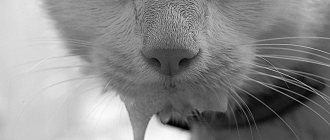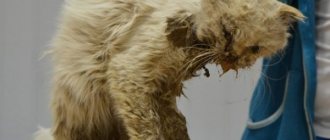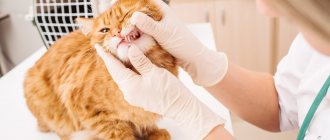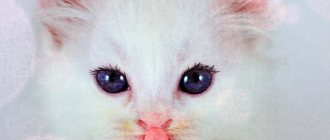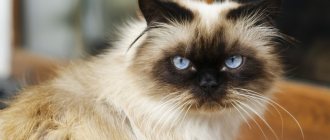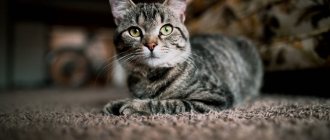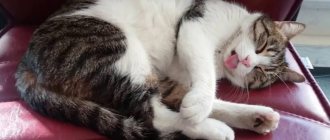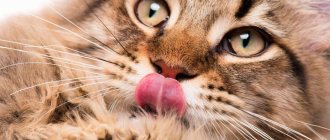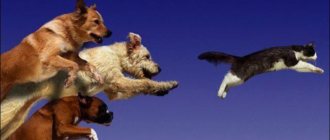Cats normally produce saliva in small doses. Excessive salivation occurs before eating, during feeding, changing teeth, from bitter medicines, and when it is necessary to lick the fur. It’s normal if the fur around the mouth is slightly damp; you need to worry if the moisture saturates the entire face and drips onto the floor. A cat's dripping drool is a sign of many conditions at once, and it is necessary to find out what happened as quickly as possible.
Functions of saliva
Saliva is a secretion that can be watery if it comes from the serous glands, or viscous if it comes from the mucous glands. It contains up to 99.5% water. In addition, the composition includes:
- electrolytes – anions and cations;
- proteins in small quantities;
- mucin
Saliva performs the following functions:
- protects teeth, gums and oral mucosa from damage;
- softens food, makes it easier to chew food;
- extracts flavor elements from food;
- helps the formation of a food coma, which is easier to swallow;
- is able to disinfect and stop bleeding due to the presence of thromboplastic components in the composition.
Acute pharyngitis
Acute pharyngitis can occur independently, and can also be accompanied by acute inflammation affecting the upper respiratory tract: rhinitis or inflammation of the mucous membranes of the nasopharynx.
Depending on the cause of development, acute pharyngitis occurs:
- Viral – most often caused by rhinovirus;
- Bacterial – caused by streptococci, staphylococci and pneumococci;
- Fungal – source of the inflammatory process – Candida;
- Traumatic - caused by damage to the pharynx and larynx: the throat was scratched by a sharp bone or burned by boiling water, severe stress on the ligaments;
- Allergic – occurs when inhaling allergens or irritants, such as tobacco, exhaust fumes or dusty air.
Increased salivation in a cat
First of all, let's learn how to examine an animal's oral cavity and highlight some of the main symptoms. And try not to panic prematurely.
There are a number of safe reasons for drooling. This is often normal:
- the animal smelled or saw food;
- during feeding and chewing food;
- many people wonder why a cat drools when you pet it, but it just enjoys it;
- the pet experiences a nervous experience;
- the cat or kitten ate something bitter or was given a tasteless medicine, for example, for worms.
As a rule, in such cases, the volume of discharge in a healthy cat only slightly increases. It can be seen in the fur around the mouth. Don't worry if this process does not take more than 10-15 minutes. Otherwise, measures must be taken.
Reasons for the development of pharyngitis
Experts believe that the peak development of pathology occurs at the end of winter and the beginning of spring, since at this time the human immune system is especially susceptible to colds. Often in the spring season, a lack of vitamins and microelements in the human body leads to the appearance of vitamin deficiency, the body weakens and creates an excellent environment for the development of pathogenic bacteria. Inflammatory processes are also possible: both separately and against the background of the underlying disease.
The first signs of pharyngitis and its further treatment may differ depending on the stage of the pathology, gender, age and general health of the patient.
We include the following as the main reasons for the development of pharyngolaryngitis:
- hypothermia, eating too cold foods;
- deformation of the nasal septum;
- strains of microorganisms that cause the development of chlamydia, candidiasis, whooping cough, scarlet fever, measles;
- adenovirus, influenza virus;
- streptococci, staphylococci, pneumococci;
- sinusitis, tonsillitis, caries, rhinitis;
- difficulty breathing through the nose;
- pathologies of the gastrointestinal tract: reflux, heartburn, hernia;
- abuse of bad habits;
- regular high loads on the vocal cords;
- polluted, toxic air;
- hormonal disorders and endocrine pathologies (diabetes mellitus, obesity, hypothyroidism, etc.);
- tonsillectomy, which was performed on the patient previously;
- infectious diseases in chronic form;
- weakened immunity.
What diseases cause cats to drool?
Drooling or salivation may indicate certain diseases in your pet.
If your cat's teeth are drooling and falling out, periodontal disease and associated gingivitis (bad odor) and dysphagia (difficulty eating) may be the cause. X-ray examination may be required to determine the characteristics and extent of the disease.
The animal often rubs its mouth with its paw. These are signs of stomatitis and (or) gingivitis. In this case, the most profuse salivation is possible. Treatment consists of taking antibiotics and anti-inflammatory drugs. In exceptional cases, tooth extraction will be required.
If the tongue sticks out and drools heavily, this may indicate a broken tooth with damage to the nerve endings, or damage to the temporomandibular joint, as well as be a manifestation of some other injuries.
Malocclusion. May occur in the presence of tumors in the oral cavity. Cancerous tumors in this area are a common cause of drooling in older cats.
When a cat drools while sleeping, it could be a sign of uremia (kidney failure), a common disease most common in older animals. A sure symptom of the disease is bad breath.
There are also several other reasons. For example, frequent nausea may indicate the presence of serious liver disease. If the liver does not work properly, toxins accumulate in the animal's blood. Nausea and accompanying drooling are the first clinical signs of liver disease.
However, do not forget that a number of other diseases also cause nausea. Do not try to cure your pet yourself. Only specialists from a veterinary clinic can conduct a full diagnosis and prescribe comprehensive treatment.
Chronic pharyngitis
According to the depth of damage to the pharyngeal mucosa, chronic pharyngitis is divided into: catarrhal, hypertrophic and atrophic forms.
- Chronic catarrhal pharyngitis - there is slight swelling of the tissue layers of the pharyngeal mucosa. Individual areas are sometimes covered with clear or slightly cloudy mucus. It develops as a result of acidic gastric contents entering the throat, for example, in the case of a hiatal hernia. Therefore, catarrhal chronic pharyngitis is a consequence of the development of diseases of the gastrointestinal tract.
- Chronic hypertrophic pharyngitis is a significant severity of swelling of the mucous membrane. Additionally, thickening of the uvula and swelling of the soft palate are observed.
- Chronic atrophic pharyngitis is characterized by some thinning of the lining of the pharynx. They are usually pale pink, sometimes shiny varnished. Some of their areas become covered with crusts, viscous mucus and pus.
Any type of chronic pharyngitis develops due to the fact that the acute form of the disease was not cured in time and developed into a more serious form. Chronic pharyngitis also appears as a consequence of rhinitis, sinusitis, deviated nasal septum, nasal polyps - that is, when nasal breathing is difficult for a long time. In addition, long-term use of vasoconstrictor drops also leads to the appearance of chronic pharyngitis.
Symptoms and signs
Heavy salivation in a cat can be accompanied by various physiological changes. They are not difficult to spot.
- The cat does not eat anything and is drooling. This happens with gastrointestinal diseases or viral diseases. At the same time, if you notice that your pet refuses to eat, but is drooling profusely, you should not leave everything to chance and it is better to contact a veterinarian.
- The cat stopped taking solid food, which he used to eat with great desire. This may indicate problems with the mouth, teeth, or digestive system. Also, hard pieces of food may fall out of the mouth, and the animal holds its head in an unusual position.
- Changes in cat behavior. Just like us, cats experience some discomfort when they are sick. This may affect behavior - increased aggressiveness or irritability is noticeable.
- The cat's eyes water and drool, she has difficulty swallowing food, she feels nauseous and vomits - symptoms associated with drooling that indicate digestive problems.
- The cat is drooling and has bad breath. If there are any problems in the oral cavity, the pet begins to frequently rub its face.
So, we have determined why the cat is drooling. We also figured out what accompanying symptoms may indicate health problems. Now it's time to understand what to do if your cat is drooling.
Adviсe
Here are a few tips that you need to know and, if possible, follow if you want to return your pet's saliva production to normal :
- the very first thing is to hide all substances, drugs and preparations that are dangerous to its health in a place inaccessible to the cat;
- give more fluid so that the animal’s metabolism is activated and there is no dehydration;
- Products should be introduced into the cat’s diet gradually, starting only with liquid food;
- In order not to aggravate the situation and avoid its recurrence, carefully monitor what you feed your cat: you should not give it bony fish or food that may contain small hard pieces;
- if there is any damage to the oral cavity, it must be promptly treated with disinfectants;
- When treating your pet's fur for fleas and ticks, put a bandage on the cat's neck to prevent the cat from licking the preparation from the fur.
If salivation decreases, the amount of saliva gradually returns to normal, then all the doctor’s recommendations are being followed, and your pet is on the mend.
What to do if your cat is salivating excessively
If you notice that your cat is drooling a lot, you should immediately call a veterinarian for help. Only a doctor can make an accurate diagnosis. He examines the animal, assesses the nature of salivation, determines its causes and prescribes treatment on this basis. There is no point in doing this on your own; it will only make things worse.
A professional knows how to examine the animal completely, including the oral cavity, without unnecessary discomfort for the animal. In this case, the doctor correctly determines the cause of increased salivation. At home, it is extremely difficult to remove a foreign object if it gets into the esophagus or pharynx. And the doctor will do this quickly and accurately.
When an animal is diagnosed with a disease, the veterinarian prescribes medications and gives useful recommendations to the owners on how to proceed. This helps to cure your pet as quickly as possible.
Drooling in cats is quite common. Fortunately, its causes are rarely associated with danger to the life of pets. But if problems are detected, it is better to consult a doctor immediately.
Original publication: Why Is My Cat Drooling? Author: Arnold Plotnick, DVM
In what cases does an animal require treatment?
Treatment is required for any pathological cause, since self-healing is an extremely rare phenomenon. To determine the necessary medications, the pet will have to undergo tests and undergo all examinations recommended by the doctor.
Do not delay contacting the veterinary clinic if alarming symptoms are detected. Timely treatment begins significantly reduces the risk of developing possible complications.
Heatstroke
Flat-faced cats, such as Persians, have a higher risk of heatstroke, which can cause drooling. Although heatstroke is not as common in cats, too much time in the sun or not drinking enough water can have detrimental effects.
Cats love the sun. Always have fresh, clean water on hand. In the summer, make sure your cat has shady places to cool off. Keep your cat indoors on hot days. Never leave a cat in a parked car. Limit training and play time to keep your cat from overheating.
Caustic poisons
Cats cannot metabolize chemicals and medications well. This is due to their altered metabolism in the liver, called glucuronidation.
Corrosion from chemicals (washing detergents, floor cleaners, weed killers, etc.) can cause burns to the mouth, tongue, esophagus and stomach. If swallowed, they can cause poisoning and severe drooling.
If you suspect that your cat has recently been exposed to a caustic chemical, you should rinse her mouth with water. After rinsing, offer your cat something she will enjoy drinking, such as chicken broth. This will flush the esophagus and loosen the toxin in the mouth.
Diagnosis of pharyngitis
Detection of all types of pharyngitis begins with a visual examination of the larynx using a special device and taking an anamnesis. A throat swab is also taken for examination to test for diphtheria.
Other types of diagnostics:
- Cultural examination - inoculation of taken materials on a nutrient medium.
- Rapid diagnosis - identification of streptococcal antigen in throat swabs.
- Immunoserological diagnosis - the method is used in case of streptococcal infection.
Laboratory research:
- Complete blood count – exclusion of blood diseases, infectious mononucleosis;
- A general urine test helps rule out kidney disease (glomerulonephritis).
Depending on the symptoms of the disease, as well as the condition of the larynx, the presence or absence of cough, fever, plaque on the tonsils and soreness and increased size of the lymph nodes, additional consultations with other specialists may be necessary: an endocrinologist, a cardiologist, an allergist.
Poisonous plants
According to Mark S. Thompson, plants containing insoluble calcium oxalate crystals can cause a severe burning sensation in the mouth if your cat accidentally ingests them. Plants that are poisonous to cats include:
- Peace Lily
- Calla Lily
- elephant ear
- Dieffenbachia
- umbrella plant
- mother in law tongue
Insoluble calcium oxalate in plants causes minimal toxicity in cats, but can cause unpleasant reactions. If you have one of these plants and you suspect a cat has gotten into it, rinse its mouth with water and then give the broth.
Veterinarian help
If there is sudden drooling, profuse discharge, or other signs are observed, then the animal needs urgent medical attention.
Alarming symptoms of drooling:
- inappropriate behavior of a pet;
- no reason for stress;
- changes in the volume of saliva produced during the day;
- drooling for more than 1.5 hours;
- the situation is getting worse.
The animal's oral cavity is first examined to rule out non-viral diseases.
Respiratory diseases
Viral respiratory diseases can lead to ulcerations in your cat's mouth. This may cause mouth pain and increased salivation. Cats that live in shelters or multi-cat homes have a higher risk of respiratory infections.
The veterinarian must treat infections. However, you can take steps to prevent your cat from becoming infected. Some of these include keeping your cat indoors, ensuring up-to-date vaccinations, limiting interactions with other pets, and washing your hands after handling other animals.
